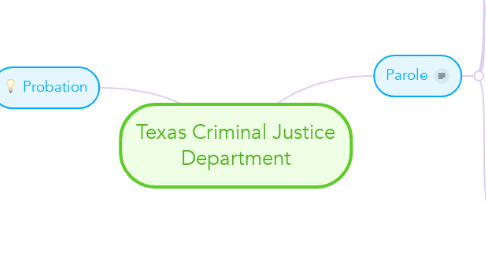
1. Probation
1.1. Absconde Warrant Unit
1.1.1. Defense tactics
1.1.2. Public safety awareness
1.1.3. Probation violation warrant
1.1.4. Authorized to carry impact weapons, (ASP batons) handcuffs, capsicum spray, firearms
1.2. Assessment center
1.2.1. Pre-sentence investigation reports
1.2.2. PSI/ Summary's
1.2.3. Criminal history
1.2.4. Risk/Need
1.2.5. Diagnostic screening
1.2.6. Evaluations
1.3. Assessment, Treatment, and Research Services (ATSR)
1.3.1. Accepts indigent and non-indigent clients if the court orders a program fee.
1.3.2. Clients are referred by the felony courts and by community supervision officers.
1.3.3. Outpatients substance abuse treatment averages approximately 17 weeks.
1.3.4. Specific referral criteria can be obtained directly from ATRS.
1.4. Dual Diagnosis Center
1.4.1. Felony only with diagnosed drug abuse or dependence
1.4.2. No title V offenses
1.4.3. Major Mental Illness (Major Depressive Disorder, Bipolar Disorder or Schizophrenic Spectrum Disorder)
1.4.4. Court order entry only
1.4.5. Not imminently suicidal or homicidal
1.4.6. Males and females
1.5. High Risk Caseload Diversion Program
1.5.1. Offender must reside or be employed in Dallas County
1.5.2. Must have a condition of community supervision requiring participation in a cognitive behavioral program such as “Thinking for a Change, BIPP, Anger Management, etc
1.5.3. Must be court ordered into High Risk Caseload as a condition of community supervision and not as a condition of bond or pre-trial bond
1.6. Judge John C. Creuzot Judicial Treatment Center
1.6.1. Felony only with diagnosed drug dependence
1.6.2. No title V offenses, no severe medical or mental health problems (except for the Dual Diagnosis Center and Pre-DDC track)
1.6.3. Court order entry only
1.6.4. Males and females
1.7. Mental Illness/Mental Retardation Caseloads (MIMR)
1.7.1. Priority given to high-risk felons with diagnoses of Schizophrenia, Schizoaffective Disorder, Bipolar Disorder and Major Depressive Disorder
1.7.2. Provides a continuum of supervision based on stabilization and actuarial risk
1.7.3. Provides for coordination of services with treatment providers including Intensive Case Management services through the Special Needs Offenders Program (SNOP)
1.7.4. The MIMR program does not generally accept sex offenders. These clients will be seen by the sex offender treatment unit
1.8. Motivational Interviewing Training Unit
1.8.1. Client-centered, directive method for enhancing intrinsic motivation to change by exploring and resolving ambivalence.
1.9. SAFPF Unit
1.9.1. Felony only from SAFPF inpatient facilities
1.9.2. Court ordered participation only
1.9.3. All offenders are supervised at a maximum risk level designation
1.9.4. Selected offenders participate in SAFPF Re-Entry Courts
1.10. Sex Offender Unit
1.10.1. Client participation in the Sex Offender Unit must be court ordered and is limited to offenders who meet the definition of a sex offender as defined in TDCJ-CJAD standards
1.10.2. The Sex Offender Unit incorporates a substance abuse treatment referral component for those offenders who abuse alcohol or drugs as well as a cognitive behavioral component for each offender that includes an evaluation of the offender upon entering the program and an evaluation upon exiting the program
1.10.3. Community Supervision Officers in the unit work closely with local police departments to ensure the safety of the community
1.10.4. Clients are supervised in the Sex Offender Unit until such time as they no longer represent a serious risk to the community
1.11. Transportation and Safety Unit
1.11.1. All clients are seen based on the “risk” they pose to the community
1.11.2. Presently, have 34 officers perform fieldwork duties for Dallas County CSCD
1.11.3. In order to provide the surveillance necessary for the protection of the community and to comply with CSCD requirements, the FWO must often work weekends, late nights and early mornings
1.11.4. The FWO is assigned a CSCD fleet vehicle for conducting fieldwork
1.11.5. The FWO must communicate effectively in a verbal and written manner, provide help or case coverage to other fieldwork officers when needed, and prepare monthly statistical data as required
1.11.6. The FWO is a member of the supervisory team and works collaboratively with the casework officer in the supervision of maximum risk clients
1.12. Court Services Unit
1.12.1. Providing significant information to the courts to assist the judges with sentencing decision, the issuance of arrest warrants and other judicial actions;
1.12.2. Collaborative partnership with the community to provide research based prevention and intervention services;
1.12.3. Assessing offenders risk/needs in order to help guide decisions regarding treatment services and appropriate level of supervision;
1.12.4. Managing offender risk by enforcing court orders while providing opportunities for positive behavioral change within our communities;
1.12.5. Facilitating victim involvement and restorative justice services
2. Parole
2.1. COPE
2.1.1. Community opportunity programs for education offers offenders a means of obtaining eduactional services in the community.
2.2. Substance abuse counseling programs (SACP)
2.2.1. Program started back in 2005 to reduce the recidivism rate of offenders using drugs while in parole
2.3. Parole division councelors
2.3.1. Provides relapse prevention services
2.4. District reentry centers (DRC)
2.4.1. Rehabilitation in the following core areas;
2.4.1.1. Substance abuse
2.4.1.2. Cognitive reconstruction
2.4.1.3. Anger management
2.5. Serious and Violent Offender Reentry Initiative Program (SVORI
2.5.1. Must be assigned to Administrative Segregation, Security Detention Level I
2.5.2. Must have time earning status of Line Class I or above
2.5.3. No state jail confines
2.5.4. No active felony or INS or ICE detainer
2.5.5. Not in disciplinary status as a result of a major penalty
2.5.6. No consecutive sentences pending parole review
2.5.7. Must have at least 10 months before release on parole or minimum expiration date at program screening
2.5.8. Minimum of 24 months to maximum expiration date at Board of Pardons and Paroles review

